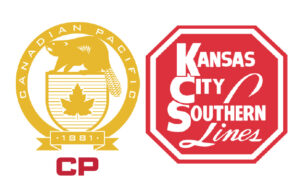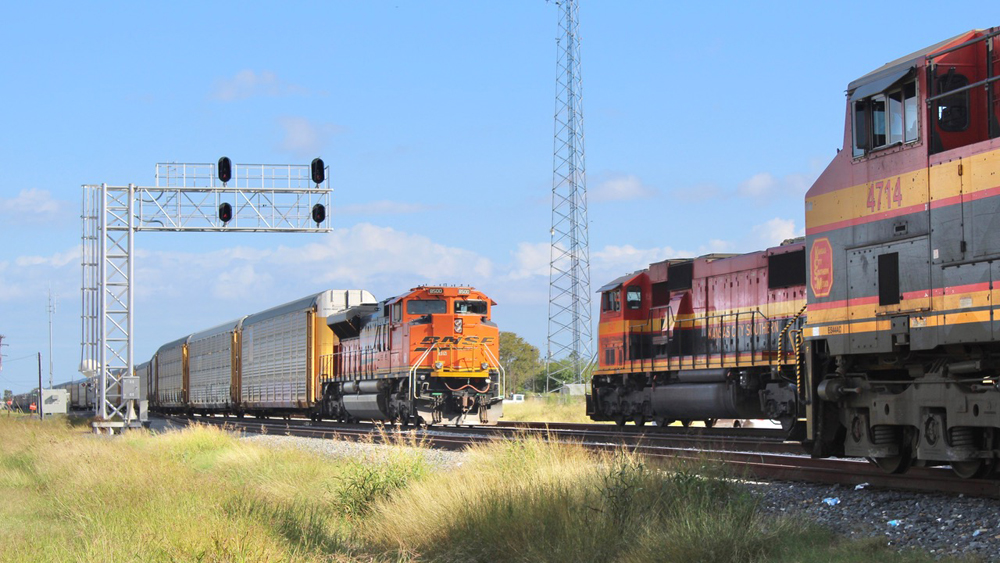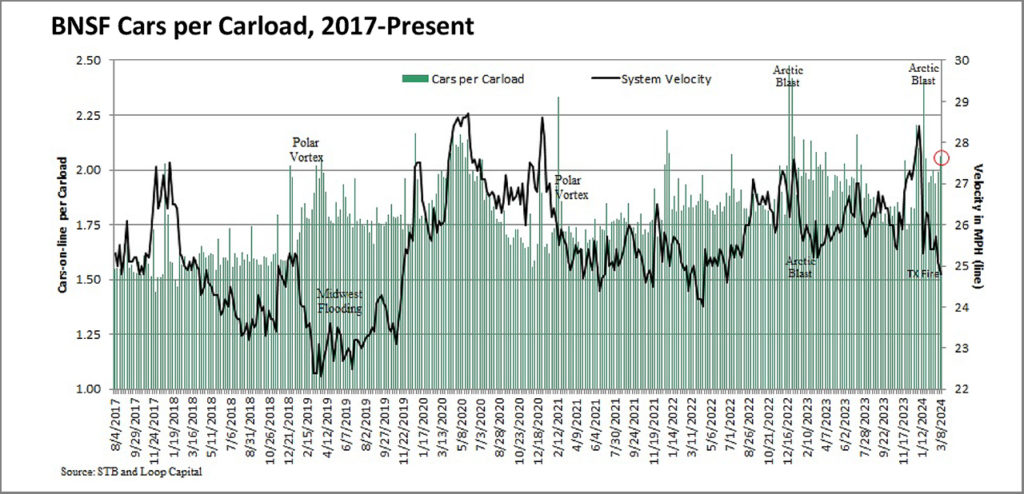Noi Mahoney
Fri, March 1, 2024

BNSF Railway has reportedly furloughed 362 employees across the U.S. in a cost-cutting measure, according to the Transportation Trades Department with the AFL-CIO, the transportation labor federation representing U.S. rail unions and workers. (Photo: Jim Allen/FreightWaves)
BNSF Railway, one of the largest freight railroads in the U.S., has reportedly furloughed hundreds of employees in Kansas, Montana, Nebraska and Texas.
The furloughs were announced Tuesday, with 362 workers reportedly losing their jobs, according to the Transportation Trades Department (TTD) with the AFL-CIO, the transportation labor federation representing U.S. rail unions and workers.
“BNSF Railway callously announced it has furloughed over 362 mechanical department positions at numerous locations across their system,” Greg Regan, president of the TTD AFL-CIO, said in a letter obtained by FreightWaves. “BNSF has said that the slashing of these positions was necessary to realign with their business operations and to respond to business decline.”
Workers at BNSF terminals were reportedly furloughed at rail terminals in Kansas, Montana, Nebraska and Texas, according to posts on social media. While TTD AFL-CIO said the furloughs were in the mechanical department, social media posts indicated positions such as clerks, carmen, pipe fitters and laborers were also affected.
Fort Worth, Texas-based BNSF, whose total revenue in 2023 declined 8% year over year to $23.8 billion, said it is offering transfers and retraining for affected workers.
BNSF representatives issued a statement to FreightWaves about the furloughs:
“While the underlying economy currently lacks clarity, BNSF is pursuing and capturing growth in several areas. We have an imbalance of employees where growth is occurring among some of our mechanical work groups.
“We have team members in locations on the network where there isn’t sufficient work and simultaneously not enough team members where the growth is occurring. Work groups must be readjusted to ensure we have the right people in the right place at the right time to best serve our customers’ current transportation needs and be positioned for future growth.
“BNSF has offered location transfers with incentives targeted to those locations where there are open positions. BNSF has also offered craft transfers for mechanical employees to be retrained for other open positions on the BNSF network. There are currently several hundred open mechanical and engineering positions on our network. Our hope is that we can reallocate personnel through these incentive programs, so BNSF continues to grow with our customers.”
Regan said BNSF has notified the union that 150 mechanical jobs will be made available across the country for furloughed workers to reapply but could require workers to relocate and accept lower pay.
“If mechanical employees were to switch crafts they would be forfeiting their established seniority … by transferring to new locations, different mechanical crafts or the maintenance of way department positions,” Regan said. “They would be effectively starting their railroad careers over, as seniority is the cornerstone of work opportunities within the railroad industry.”
In the wake of the furloughs, the TTD AFL-CIO demanded immediate federal inspections of BNSF locomotives and rail cars.
“We urge the Federal Railroad Administration to immediately conduct unannounced focused inspections of all BNSF owned and leased locomotives and rail cars … and further issue non-compliance orders requiring BNSF to repair any defects before being permitted to utilize their locomotives and rail cars,” Regan wrote. “We have long-held concerns about numerous defects that are intentionally being ignored and neglected by BNSF because managers … are under pressure to perform work with an inadequate number of workers. These problems will only be exacerbated by the extreme mechanical department cuts that were carried out by BNSF.”
BNSF has over 40,000 employees and operates 32,500 miles of rail across the U.S.
John Kingston
Fri, March 1, 2024

The fur was flying Thursday and Friday over two class 1 railroads.
Charges, countercharges and the missives were flying back and forth over the future of two Class 1 railroads as February came to an end, with leading government officials that regulate the rails leveling heavy criticism at two distinct players.
In the proxy battle roiling Norfolk Southern (NYSE: NSC), the activist investor group Ancora is recommending the replacement of eight new directors to the Norfolk Southern board. It also wants to replace CEO Alan Shaw with former UPS executive Jim Barber and name Jamie Boychuk, a former executive at CSX, to replace current COO Paul Duncan.
The scorecard for the criticism and the responses over a mere two days went like this:
— Martin Oberman, chairman of the Surface Transportation Board, ripped into Ancora Associates for its proxy battle over Norfolk Southern (NYSE: NSC) railroad. Oberman spoke to the Southeast Association of Rail Shippers 2024 Spring Meeting in Atlanta on Thursday, where he said Ancora “has nothing to say about what it could do better” than current management in running Norfolk Southern, adding, “I think we can assume that if Ancora succeeds in its bid to control NS, its next move will be to put the Brooklyn Bridge on the market.”
— Ancora didn’t have any public response to Oberman’s comments, but on Friday, it sent a letter to the Norfolk Southern board, just a few days after the railroad released its 2024 proxy statement. The proxy revealed that in 2023 — the year when Norfolk Southern labored under the fallout from the derailment in East Palestine, Ohio — NS CEO Alan Shaw had total compensation of $13.41 million, compared to $9.78 million a year before.
— The second blast from a government official aimed at a railroad came from Amit Bose, the administrator of the Federal Railroad Administration. In a letter addressed to UP CEO Jim Vena,
Bose criticized recent furloughs implemented at Union Pacific (NYSE: UNP). “It is imperative that UP prioritizes safety above all else and takes immediate steps to address this issue, an issue disproportionately affecting UP workers since your railroad continues to furlough employees at a rate, based on available data, far outpacing that of any of your Class I peers.” Bose wrote.
— Union Pacific quickly responded to Bose’s comments with a letter from Vena, which said the FRA head was portraying an “inaccurate correlation between natural workforce fluctuations and safety.”
Oberman was harsh in his assessment of Ancora’s motives. “Several weeks ago, Ancora wrote me a letter,” Oberman said, according to a transcript released by the STB. “The essence of their message was that they had taken a $1 billion dollar stake in NS in order for it — quote — ‘to become a safer railroad.’ Really? What hedge fund raises $1 billion to promote safety anywhere?”
Oberman, as he has done before, criticized railroad focus on its operating ratio (OR), with the STB head expressing concern that a goal to reduce OR can come at the expense of both safety and performance.
“Ancora principally and repeatedly focuses on a rapid lowering of the OR to drive cash payouts and raise its stock price, harshly criticizing present NS management for not making a lower OR the objective,” Oberman said. “We now know that this is wrong-headed thinking. Making OR the corporate objective is what led to elimination of thousands of workers which caused the service crisis.”
The reference to the service crisis was from earlier in his speech when he recapped STB actions to force service improvements during the enormous system backups of 2022.
Ancora’s Friday letter was addressed to Amy Miles, the non-executive chair of the NS board. The letter said that Ancora — which as an activist investor has previously trained its sights on Forward Air (NASDAQ: FWRD) and C.H. Robinson (NASDAQ: CHRW) — said Shaw has “presided over industry-worst operating results, sustained share price underperformance and an ineffective and tone-deaf response to the preventable derailment in East Palestine.” It said Anchor had “offered viable solutions in the form of exceptional people with a strategic vision.”
Norfolk Southern’s stock price in the last 52 weeks is up about 14%. During that time, its fierce rival for business east of the Mississippi, CSX (NASDAQ: CSX), is up about 23.7% while Union Pacific is up 21.5%.
Focusing in on Shaw’s pay package from 2023
On the issue of Shaw’s pay, the Ancora letter said shareholders were “baffled” at the decision to give the CEO a raise in the same year as the East Palestine derailment and the fallout from it.
“We challenge the Board’s determination that it had to adjust executive compensation in 2023 to ‘retain key talent,’” Ancora said, quoting a board statement. “We do not see how the Board could have actually viewed Mr. Shaw as a flight risk. In addition to being a more than 30-year insider at Norfolk Southern, he was a relatively new, unproven CEO off to an extremely rocky start. The fact that this decision was made suggests deference to management and a lack of respect for shareholders and stakeholders.”
UP furloughs at issue
In the back-and-forth surrounding Union Pacific, Bose said UP’s decision to furlough some worker is a sign that the railroad “has again chosen to prioritize cost-cutting measures over ensuring safe operations, jeopardizing the well-being of both UP’s workers and the public.”
“Furloughing maintenance of equipment workers puts a strain on workers across the railroad, leading to fatigue and potential errors that could have severe ramifications for both workers and the public,” Bose wrote.
In a letter signed by Vena, UP responded to Bose’s criticism with several key rebuttals.
— It cited several statistical points about derailments, that “serious” derailments were down 26% in 2023 from 2019 levels, track-related derailments had declined 28% in the past 10 years, and that UP had recorded an 8.7% improvement in mainline derailments in 2023 versus 2021.
— The Vena letter said “fluctuations in workforce needs are a natural component of operating the railroad … normal, cyclical and vary from year to year based on business needs, capital projects and weather.”
To support its criticism that Bose was not making distinctions among types of workers and railroad needs, Vena’s response said the Bose letter “combines different types of workers (Mechanical employees and Engineering employees) and work done on the railroad (equipment maintenance and capital projects), and therefore paints an incorrect and incomplete picture of the natural role workforce fluctuations play in operating a railroad year-round.”
“We’ve already begun seeing an increase in demand and have more employees working in January and February of this year,” Vena wrote.
The letter also said workers impacted by furloughs and layoffs can apply for other positions at Union Pacific.











